Components and datasheets here,
The HV components have reference designators in the 100-series; the LV side components are -200 and -300 series. e.g. resistors, capacitors, transistors, ICs.
FUSE101, 450V 20A, marked "NEW"
IC209, Linear Tech LT1461DH5, LDO 5V reference, https://static6.arrow.com/aropdfconversion/b3fcd775414358d81f9c4170fe3a25b851538c67/1461f.pdf
Q229, marking code "CGRZ", 2SC5053, NPN 50V, 1A,
IC101, NEC uPC1099G, switching regulator, https://www.datasheetarchive.com/pdf/download.php?id=d0ee29cce8e9c9dd89fa4a4c02a63a692ac8e4&type=O&term=UPC1099
IC102, etched ?, likely an NEC uPC277 dual comparator;
https://www.renesas.com/us/en/doc/DocumentServer/006/G17934EJ3V0DS00.pdf
IC208, NEC uPC1251 dual op amp, https://datasheetspdf.com/pdf-file/1037858/Renesas/UPC1251/1
IC202, NEC uPC177GR, quad comparator, https://pdf1.alldatasheet.com/datasheet-pdf/view/216924/NEC/UPC177GR-9LG.html
IC203, "277" NEC uPC277, dual comparator, https://www.renesas.com/us/en/doc/DocumentServer/006/G17934EJ3V0DS00.pdf
PC101, NEC PS2703 photocoupler, https://media.digikey.com/pdf/Data%20Sheets/NEC%20PDFs/PS2703-1.pdf
Q110, Fuji 2SK3983 N-MOSfet, 900V, 2.6A, 6.4Ω, https://americas.fujielectric.com/files/2SK3983-01L.PDF
Q109, NEC 2SC4942, NPN 600V, 1A, https://alltransistors.com/pdfdatasheet_nec/2sc4942.pdf
Q101-104 are Fuji 2SK3697 N-MOSFETs, 600V, 42A, 14mΩ, https://americas.fujielectric.com/files/2SK3697-01.PDF
Diode Module, Nihon Inter Electronics, P2H80QH20, https://www.digchip.com/datasheets/download_datasheet.php?id=1620301&part-number=P2H80QH20
Small signal transistors identified by marking code and reference designators:
"K N", PMV48XP or Toshiba 2SJ305 P-channel FET; Q211, 212, 218, 233
"L 6", NEC 2SC1623 NPN; Q205, 207, 213, 214, 222, 223, 227, 232, 234
"S 6", seems to be PNP ; Q208, 210
"G16", seems N-mosfet; maybe IRL2502. Q203, Q111, Q219, Q220; https://alltransistors.com/pdfview.php?doc=irlml2502pbf-1.pdf&dire=_international_rectifier
IC201, TI UC2825AQDW, High Speed PWM Controller (FET gate driver), https://www.ti.com/lit/ds/symlink/uc2825a-q1.pdf
IC204, IC205; VHC14, Hex Schmitt Inverter, https://media.digikey.com/pdf/Data%20Sheets/Toshiba%20PDFs/TC74VHC14F,%20FK,%20FN,%20FT%20Rev2006.pdf
IC207, VHC08, Quad 2-In AND gates, https://www.onsemi.com/pub/Collateral/MC74VHC08-D.PDF
CS201, LEM HC2H200-S, Hall-Effect Automotive Current Transducer, https://www.lem.com/sites/default/files/products_datasheets/hc2h200-s%20clips.pdf
Transformers:
TR101, TR102, ZT0622-TRS-GD, Gate Drivers for Q101-104
TR103, Step-down Power transformer mounted to heatsink, TDK 202V0A3
TR104, ZC19A105, signal transformer for output of power transformer
TR105, CS3871A JXE SUMIDA, HV primary with 2 LV secondaries
Inductors:
L201, large flat-wire output inductor, TDK 202V0A1


















